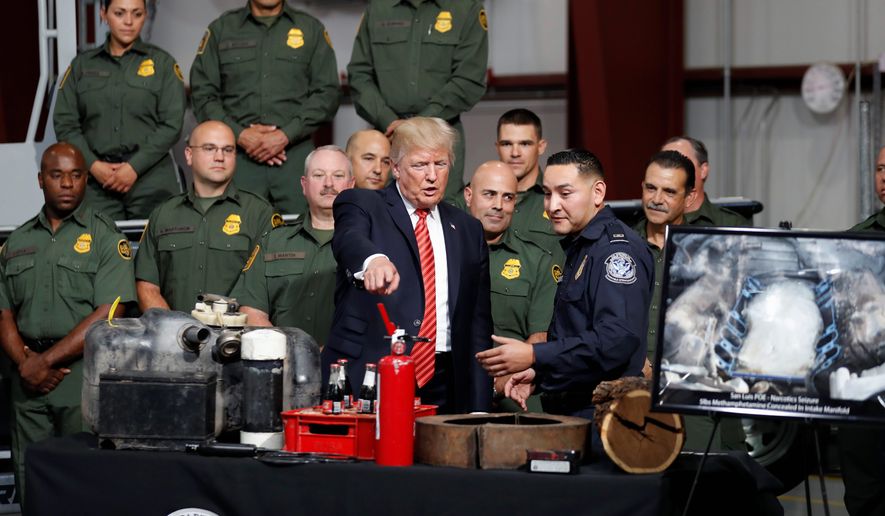YUMA, Arizona — President Trump did a quick tour Tuesday of border security infrastructure in Arizona as his top homeland security aides stepped up pressure on Congress to approve money for new fencing and additional agents, saying they will keep Americans safe and prevent illegal immigrants from making the dangerous journey in the first place.
Citing early success in cutting the flow of illegal immigrants, top officials said they still need more fencing to help funnel the illegal traffic, and promised to keep pressing enforcement inside the U.S. to convince people they’re likely to be deported even if they do breach the border.
Mr. Trump’s Yuma stop came en route to Phoenix, where he had a highly anticipated campaign rally set for later Tuesday. The rally is his first since the Charlottesville, Virginia, clashes between white supremacists and “antifa” counterprotesters, and the first since the president said he was considering pardoning former Maricopa County Sheriff Joe Arpaio.
The Phoenix location had left Arpaio backers hoping for news Tuesday, but the White House said it wouldn’t happen.
“There will be no discussion of that today at any point, and no action will be taken on that front at any point today,” press secretary Sarah Sanders said.
Instead, the trip was intended to try to regain footing after a rough week that saw Mr. Trump take fierce criticism from both Republicans and Democrats over his handling of Charlottesville and firing his chief strategist, Steve Bannon.
SEE ALSO: Trump taunts John McCain, Jeff Flake at Phoenix rally
Turning to immigration made sense for the administration, which has already notched significant gains. Apprehensions of illegal immigrants on the border — a rough yardstick for the overall illegal flow — are down dramatically across the Southwest, while deportations from the interior of the U.S. are up 32 percent.
Those gains were achieved by policy changes. But officials said if they are to be improved, it will take more resources, including another round of wall-building, and agents.
“The president’s message is we need a strong border and we need strong interior enforcement. What he’s done so far has worked, so we need the funding to make it permanent. We need funding to build a wall,” Thomas Homan, acting director of U.S. Immigration and Customs Enforcement, told reporters traveling with Mr. Trump.
Congressional Democrats, and even some Republicans, are resisting those efforts, with the wall serving as a major dividing line. Outside of Congress, activists have also vowed resistance.
“Instead of solving problems along the border, walls just exacerbate flooding, destroy wildlife habitat and fragment wildlife migration corridors,” said Dan Millis, borderlands coordinator for the Sierra Club.
“Trump is waiving bedrock protections for border communities, ignoring public health and the environment and wasting U.S. taxpayer money to build a symbol of hate, fear and racism. Border communities do not support Trump’s bigoted policies like unjust travel bans or a boondoggle border wall,” he said.
SEE ALSO: Phoenix police used pepper spray on protesters throwing rocks bottles
But officials pointed to Yuma as proof of success for a wall.
Little more than a decade ago, the Border Patrol’s Yuma Sector nabbed 380 illegal immigrants on the average day. This April the Border Patrol nabbed just 244 the entire month — an average of eight per day. The numbers have risen since, but are still fewer than 30 a day.
Measured against the entire border, the Yuma Sector accounted for 12 percent of all illegal entrants based on apprehension numbers in 2005. Now that’s fallen to about 3 percent.
Homeland Security officials credited a massive border wall-building campaign under President George W. Bush, which took Yuma Sector from 5 miles of fencing and vehicle barriers to 63 miles today.
Officials also said more agents to patrol the barrier, more technology to help them detect breaches and stiffer prosecutions for those caught sneaking in rounded out the efforts that have made such a difference.
Officials said everyone is safer — from U.S. communities to the agents themselves to the migrants who aren’t making the journey anymore since the reward of gaining a foothold in the U.S. is less likely. That has forced would-be migrants to re-evaluate their risk-reward calculus.
The administration said that’s their goal, particularly when it comes to the unaccompanied alien children (UAC) or families traveling together — usually mothers and their children — who are leaving Central America believing they can make it to the U.S.
The risk of rape along the journey was so prevalent that women and girls would begin to take birth control ahead of time, at least to try to prevent pregnancy. Long walks through dangerous jungle, repeated demands for additional money and threats and beatings are also common, U.S. authorities say.
“We’re trying to dissuade, especially when it comes to UACs and family units, dissuade them from making that dangerous journey north,” one Homeland Security official said.
Also fueling the immigration debate Tuesday was a report by McClatchy news service that said the White House is looking to strike a deal that would offer legal status for young adult illegal immigrant “Dreamers” in exchange for border wall funding.
Both sides of the immigration debate rejected that kind of deal.
Those who favor a crackdown on illegal immigration said they didn’t want to see Dreamers offered permanent legal status, while immigrant rights groups said it was unconscionable to bargain with the lives of Dreamers.
“The reason Dreamers are under threat is because Republicans put them under threat,” said Frank Sharry, executive director of America’s Voice. “The idea that the Trump administration is going to exploit this self-made crisis to enact a nativist agenda is as ridiculous as it is obnoxious.”
He demanded the administration forgo plans to stiffen enforcement and instead embrace a “clean” bill granting Dreamers citizenship rights.
• Stephen Dinan reported from Washington.
• Dave Boyer can be reached at dboyer@washingtontimes.com.
• Stephen Dinan can be reached at sdinan@washingtontimes.com.




Please read our comment policy before commenting.